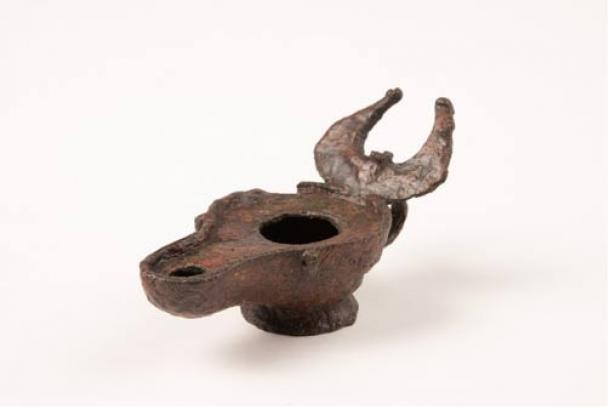
Archaeologists Uncover Ancient Roman City in Rennes, France
In Rennes, northwestern France, archaeologists have uncovered remnants of a vibrant ancient Roman city beneath a 19th-century hospital. This significant discovery, initiated in 2022, is now revealing detailed insights into the city’s structure and the daily lives of its inhabitants.
Rennes, known in antiquity as Condate, has once again revealed its hidden past through ongoing archaeological excavations. An INRAP team has unearthed significant remains dating back to between the 1st and 6th centuries AD at the site of the former Hôtel Dieu hospital.
These discoveries provide fascinating insights into the residential, commercial, and religious life of this ancient Roman city, the INRAP report explains.
- The Seven Hills of Rome: Center Stage in Rome’s Eventful History
- Ancient Lutetia: The Roman Roots of Paris

Small oil lamp found in the area searched in 2022. (© Emmanuelle Collado/ Inrap)
Discovering the Heart of Condate
Ahead of the redevelopment of the Hôtel Dieu hospital site by Linkcity, in partnership with local entities, an extensive excavation has been conducted. This project covers a total area of 5,600 square meters. This recent phase of excavation completes the archaeological studies previously conducted in the Cochardière district (2016-2017) and the Parc des Tanneurs (2017-2018).
The excavations reveal a well-planned urban landscape, with remains organized around a north-south street (cardo) and two east-west streets (decumanus). These streets intersect at right angles, creating urban blocks that combined residential and commercial functions.
Initially, the city featured buildings constructed on wooden posts with low sandpits. However, the end of the 1st century AD brought significant changes, including the introduction of masonry.
A large sanctuary with a welcoming courtyard was constructed, replacing an earlier wooden structure. New stone-built warehouses, shops, and residences emerged, fully integrating this dynamic district into the booming city of Condate.
- 2,000-Year-Old Frescoes Discovered Under the Baths of Caracalla
- The Riddle of the Roman Holey Jar – Why Would A Vessel Be Full of Holes?

Conducting a survey in the sanctuary area, at the supposed location of the temple. (© Sandrine Lalain/Inrap)
Sanctuaries and Residences: Life in the 3rd Century
In 2024, archaeologists uncovered the northern wall enclosing the sanctuary's courtyard (area sacra), which stretches over 100 meters and includes at least one temple. This religious complex is believed to be the civic sanctuary of the city of Riédons, known from inscriptions found in reused foundations of the 3rd-century wall, notes the report.
The district also housed several large private residences (domus) during this period.
One notable domus featured a grand reception room with an exedra, a space where the owner would receive guests. This room was heated by a hypocaust, an ancient Roman heating system.
The internal walls were adorned with paintings, many fragments of which have been discovered. However, by the end of antiquity, this luxurious domus showed signs of decline, with walls collapsing onto the concrete floors of its rooms.

Terracotta piles which were superimposed to allow the circulation of hot air in the hypocausts (underfloor heating). (© Cyril Cornillot/ Inrap)
Transition and Decline: From Sanctuary to Necropolis
The end of the 3rd century AD marked the decline of the district. The public sanctuary was dismantled, and stones from the enclosure wall were repurposed, likely during the construction of the castrum (fortress, castle) around 270-280 AD.A quarry was opened to the northwest of the excavation site, extracting alluvial sand. Despite this, some residences remained occupied into the 4th century, as indicated by the artifacts discovered.
A significant transformation occurred at the end of the 3rd century or the beginning of the 4th century, with the establishment of a necropolis in the ruined areas. This cemetery, which remained in use until the 8th century AD, contains over 600 tombs, with about fifty unearthed in the current excavation area. The graves, organized in rows and oriented east-west, featured deceased individuals buried in shrouds or wooden coffins.

Careful removal of a skeleton. (© Sandrine Lalain/Inrap)
Continuity and Change: Tracing Rennes' Evolution
The recent discoveries at the former Hôtel Dieu hospital site provide a comprehensive view of the evolution of Rennes from its Roman foundation to its development in the 19th century. Each layer of excavation sheds light on the dynamic nature of this urban center, revealing how it adapted and transformed over the centuries. The uncovering of residential areas, sanctuaries, and a necropolis highlights the rich historical tapestry of Rennes, offering a window into the daily lives and spiritual practices of its ancient inhabitants.
Top image: Archaeologists have uncovered remnants of an ancient Roman city beneath a 19th-century hospital in northwestern France. Source: Emmanuelle Collado/ INRAP















